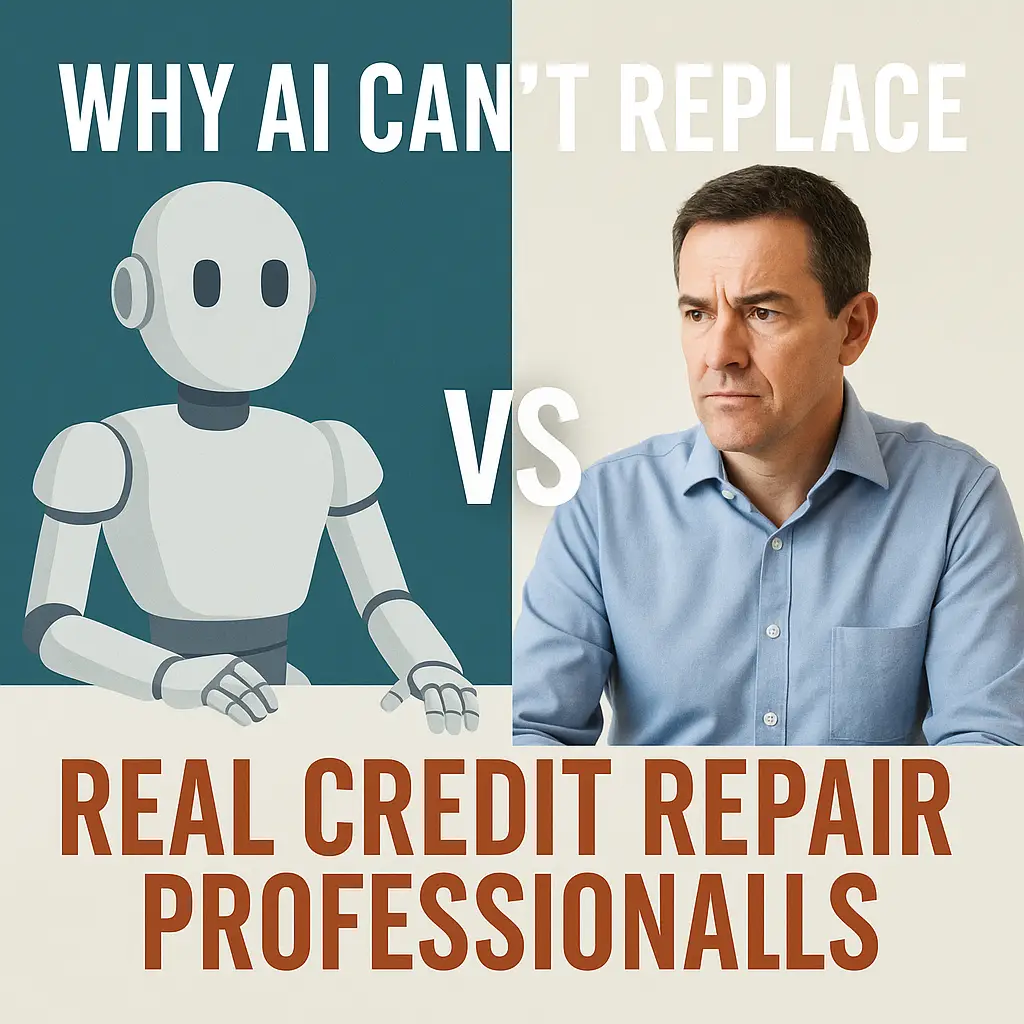The Buzz Around AI and Credit Repair
Artificial Intelligence has come a long way. From writing essays to scanning legal contracts, it feels like AI is everywhere. Naturally, some people are asking whether AI can take over credit repair too.
“Can AI really replace credit repair professionals?”
It’s a fair question. If you could upload your credit report into a machine and have all your problems fixed instantly, wouldn’t everyone be doing it already?
The reality is more complicated. AI can assist—but it can’t replace a skilled credit repair expert. Let’s look at the reasons why human experience still matters in this field, and why trusting AI alone can backfire.
1. Context and Strategy Still Require a Human Brain
AI moves fast. It can scan a report and generate letters in seconds. But credit repair isn’t about speed—it’s about understanding nuance. When a client has multiple negative accounts, including duplicates or outdated items, an AI might suggest disputing them all at once using generic templates.
A professional, however, knows how to take a more strategic approach. Here’s what a human expert brings to the table:
-
Prioritizing disputes that create the biggest score boost
-
Crafting letters designed to bypass automated rejection systems like e-OSCAR
-
Using personalized language that prompts a real human to review the case
-
Timing disputes carefully to avoid re-aging or triggering the wrong response
Credit repair isn’t about clicking a button—it’s about making the right move at the right time. That kind of judgment only comes from real-world experience.
2. The Law Is Complex—AI Isn’t a Lawyer
Credit repair demands more than just writing skills. It requires a solid understanding of federal laws, including:
-
The Fair Credit Reporting Act (FCRA)
-
The Fair Debt Collection Practices Act (FDCPA)
-
The Credit Repair Organizations Act (CROA)
-
The Telemarketing Sales Rule (TSR)
These laws evolve, and professionals must stay current. AI can’t interpret legal nuance, respond to new court rulings, or file appropriate regulatory complaints. Worse, it might generate letters that unintentionally violate those laws—or create liability for the consumer.
At American Score Increase, we don’t just follow the law—we use it to protect our clients and push for real, lasting results.
3. The Bureaus Still Rely on Human Oversight
Despite all the automation behind the scenes, credit bureaus still process most disputes through a system called e-OSCAR. When letters look like they came from a template or AI bot, they’re often ignored, flagged, or flat-out rejected.
Real professionals know how to create unique, effective letters. We also mail physical documents, include required proof, and follow up when a bureau delays or denies something unfairly. These extra steps matter—especially in complex cases.
AI tools don’t make phone calls, don’t escalate issues, and certainly don’t follow up when someone is being ignored.
4. There’s No Substitute for Personalized Support
Behind every credit issue is a real person. And that person usually isn’t just dealing with a few late payments. Financial challenges often involve identity theft, divorce, illness, job loss, or the fallout from abusive relationships.
A chatbot isn’t going to walk you through rebuilding after bankruptcy. It won’t help you understand how to rebuild your profile step-by-step. And it won’t check in to see how you’re doing emotionally.
Unlike an algorithm, a real credit repair professional will listen to your story, develop a plan tailored just for you, and stay by your side until you reach your goals. That human connection makes all the difference.
5. AI Is a Tool—Not a Replacement
Let’s be clear: AI can be helpful. I use it myself for research, note-taking, and idea generation. But I never rely on it to make key decisions or manage client outcomes.
Credit repair is like construction. The tools are important—but the builder makes the difference. AI is a screwdriver, not the carpenter.
A professional uses tools wisely, while still relying on skill, strategy, and judgment. That’s something AI simply can’t replicate—no matter how advanced it gets.
6. The Danger of DIY AI Credit Repair
Right now, some websites and YouTube influencers are promoting do-it-yourself AI credit repair strategies. They suggest using tools like ChatGPT to generate letters for you. It sounds easy—but they don’t talk about the risks.
If you send a poorly worded dispute:
-
You might trigger a fraud alert
-
You could unintentionally admit to a debt you don’t owe
-
You may waive your rights by using incorrect language
-
You might cause a re-aging of an old debt and hurt your score even more
Just because you can use AI to create a letter doesn’t mean you should. It’s like googling how to remove your own appendix—technically possible, but definitely not recommended.
What AI Can’t Do—And Never Will
AI won’t call a creditor on your behalf. It won’t write a detailed rebuttal based on your specific situation. It won’t stay up late responding to stall letters. And it certainly won’t care about your outcome the way a person does.
Credit repair is about people. It’s about restoring confidence, opportunity, and dignity. Those things require heart, judgment, and commitment—none of which can be coded into a machine.
Need Help from a Real Person?
At American Score Increase, we blend the best of both worlds—technology that improves efficiency, and people who care deeply about your success. We’ve helped thousands of people rebuild their credit with legally sound, ethical, and proven strategies.
That’s why we have a 5-star rating on Google and an A+ rating with the Better Business Bureau.
Call us today at (530) 351-4740 or visit www.americanscoreincrease.com. Let’s get you back on track—with real people, real experience, and real results.

